Actinomycin X2, an Antimicrobial Depsipeptide from Marine-Derived Streptomyces cyaneofuscatus Applied as a Good Natural Dye for Silk Fabric
Abstract
:1. Introduction
2. Results and Discussion
2.1. Isolation and Identification of Pigment-Producing Actinomycetes
2.2. Fermentation and Characterization of Actinomycin X2
2.3. Characterization of Dyed Textile
2.3.1. Optimization of Dyeing Conditions
2.3.2. Color Characteristics of Dyed Fabrics
2.3.3. Fourier Transform Infrared Spectroscopy (FT-IR) Analysis
2.3.4. X-ray Diffraction (XRD) Analysis and Scanning Electron Microscopy (SEM) Analysis
2.4. Fastness and Functional Finishing Properties of the Silk Fabrics Dyed with Ac.X2
2.4.1. Color Strength Associated with Dye Concentration
2.4.2. Color Fastness
2.4.3. UV Protection Performance
2.4.4. Antibacterial Activity and Toxicity of Brine Shrimp
3. Materials and Methods
3.1. Textile Material
3.2. Strain Isolation
3.3. Identification of Pigment-Producing Actinomycetes
3.3.1. Morphological Studies
3.3.2. Molecular Studies
3.4. Extraction and Purification of Pigment
3.5. Characterization of Pigment
3.5.1. Temperature Stability
3.5.2. pH Stability
3.5.3. Antimicrobial Activity
3.6. Textile Dyeing
3.7. Measurement
3.7.1. Fourier Transform Infrared Spectroscopy (FT-IR) Analysis
3.7.2. X-ray Diffraction (XRD) Analysis
3.7.3. Scanning Electron Microscopy (SEM)
3.8. Characterization of the Dyed Samples
3.8.1. The Influence of Dye Concentration on the Dyeing Effect
3.8.2. Color Characteristics
3.8.3. Color Fastness Testing
3.8.4. UV Protection Performance
3.8.5. Antibacterial Activity
3.8.6. Brine Shrimp Toxicity Assay
Supplementary Materials
Author Contributions
Funding
Acknowledgments
Conflicts of Interest
References
- Chattopadhyay, P.; Chatterjee, S.; Sen, S.K. Biotechnological potential of natural food grade biocolorants. Afr. J. Biotechnol. 2008, 7, 2972–2985. [Google Scholar]
- Durán, M.; Ponezi, A.N.; Faljoni-Alario, A.; Teixeira, M.F.S.; Justo, G.Z.; Durán, N. Potential applications of violacein: A microbial pigment. Med. Chem. Res. 2012, 21, 1524–1532. [Google Scholar] [CrossRef]
- Salian, A.; Dutta, S.; Mandal, S. A roadmap to UV-protective natural resources: Classification, characteristics, and applications. Mater. Chem. Front. 2021, 5, 7696–7723. [Google Scholar]
- Yusuf, M.; Shabbir, M.; Mohammad, F. Natural Colorants: Historical, Processing and Sustainable Prospects. Nat. Prod. Bioprospecting 2017, 7, 123–145. [Google Scholar] [CrossRef] [PubMed] [Green Version]
- Soliev, A.B.; Hosokawa, K.; Enomoto, K. Bioactive Pigments from Marine Bacteria: Applications and Physiological Roles. Evid.-Based Complement. Altern. Med. 2011, 2011, 670349. [Google Scholar] [CrossRef] [PubMed]
- Mansour, R. Natural dyes and pigments: Extraction and applications. In Handbook of Renewable Materials for Coloration and Finishing; John Wiley & Sons: Hoboken, NJ, USA, 2018; pp. 75–102. [Google Scholar]
- Rao, A.S.; Deka, S.P.; More, S.S.; Nair, A.; More, V.S.; Ananthjaraju, K.S. A Comprehensive Review on Different Microbial-Derived Pigments and Their Multipurpose Activities. In Microbial Polymers: Applications and Ecological Perspectives; Vaishnav, A., Choudhary, D.K., Eds.; Springer: Singapore, 2021; pp. 479–519. [Google Scholar]
- Durán, N.; Teixeira, M.F.; De Conti, R.; Esposito, E. Ecological-friendly pigments from fungi. Crit. Rev. Food Sci. Nutr. 2002, 42, 53–66. [Google Scholar] [CrossRef]
- Amal, A.; Abeer, K.; Samia, H.; El-Nasser, A.; Nadia, H. Selection of Pigment (Melanin) production in Streptomyces and their application in Printing and Dyeing of Wool Fabrics. Res. J. Chem. Sci. 2011, 1, 22–28. [Google Scholar]
- Yusoff, W.; Mohamad, S.; Ahmad, W. Fastness Properties and Color Analysis of Natural Colorants from Actinomycetes Isolates on Silk Fabric. In Proceedings of the International Colloquium in Textile Engineering, Fashion, Apparel and Design 2014 (ICTEFAD 2014); Springer: Singapore, 2014. [Google Scholar]
- Aubourg, S.P.; Torres-Arreola, W.; Trigo, M.; Ezquerra-Brauer, J.M. Partial characterization of jumbo squid skin pigment extract and its antioxidant potential in a marine oil system. Eur. J. Lipid Sci. Technol. 2016, 118, 1293–1304. [Google Scholar] [CrossRef]
- Tawiah, B.; Badoe, W.; Fu, S. Advances in the Development of Antimicrobial Agents for Textiles: The Quest for Natural Products. Review. Fibres Text. East. Eur. 2016, 24, 3–136. [Google Scholar] [CrossRef]
- Srilekha, V.; Krishna, G.; Seshasrinivas, V.; Charya, M.A.S. Antibacterial and anti-inflammatory activities of marine Brevibacterium sp. Res. Pharm. Sci. 2017, 12, 283. [Google Scholar] [CrossRef] [PubMed]
- McBain, A.J.; Ledder, R.G.; Moore, L.E.; Catrenich, C.E.; Gilbert, P. Effects of quaternary-ammonium-based formulations on bacterial community dynamics and antimicrobial susceptibility. Appl. Environ. Microbiol. 2004, 70, 3449–3456. [Google Scholar] [CrossRef] [Green Version]
- Dastjerdi, R.; Montazer, M. A review on the application of inorganic nano-structured materials in the modification of textiles: Focus on anti-microbial properties. Colloids Surf. B Biointerfaces 2010, 79, 5–18. [Google Scholar] [CrossRef] [PubMed]
- Purwar, R.; Joshi, M. Recent Developments in Antimicrobial Finishing of Textiles: A Review. Aatcc Rev. 2004, 4, 2–26. [Google Scholar]
- Simoncic, B.; Tomsic, B. Structures of novel antimicrobial agents for textiles-a review. Text. Res. J. 2010, 80, 1721–1737. [Google Scholar] [CrossRef]
- Lee, D.G. Removal of a synthetic broad-spectrum antimicrobial agent, triclosan, in wastewater treatment systems: A short review. Environ. Eng. Res. 2015, 20, 111–120. [Google Scholar] [CrossRef] [Green Version]
- Mamo, M.; Mengesha, A.; Upadhyay, R.; Dekebo, A. Studies on antimicrobial and dyeing potentials of some new oxazolidinone derivatives. J. Pharm. Res. 2012, 5, 5543–5548. [Google Scholar]
- Zhou, Y.; Tang, R.-C. Modification of curcumin with a reactive UV absorber and its dyeing and functional properties for silk. Dye. Pigment 2016, 134, 203–211. [Google Scholar] [CrossRef]
- Shah, S.S.; Shah, S.S.; Iqbal, A.; Ahmed, S.; Khan, W.M.; Hussain, S.; Li, Z. Phytochemical screening and antimicrobial activities of red silk cotton tree (Bombax ceiba L.). Pak. J. Pharm. Sci. 2018, 31, 947. [Google Scholar]
- Mahesh, S.; Manjunatha, A.; Reddy, V.; Kumar, G. Studies on Antimicrobial Textile Finish Using Certain Plant Natural Products. In Proceedings of the International Conference on Advances in Biotechnology and Pharmaceutical Sciences (ICABPS’2011), Bangkok, Thailand, 23–24 December 2011. [Google Scholar]
- Hussain, A.I.; Anwar, F.; Chatha, S.A.; Latif, S.; Sherazi, S.T.; Ahmad, A.; Worthington, J.; Sarker, S.D. Chemical composition and bioactivity studies of the essential oils from two Thymus species from the Pakistani flora. LWT-Food Sci. Technol. 2013, 50, 185–192. [Google Scholar] [CrossRef]
- Teli, M.; Pandit, P. Application of Sterculia foetida fruit shell waste biomolecules on silk for aesthetic and wellness properties. Fibers Polym. 2018, 19, 41–54. [Google Scholar] [CrossRef]
- Chandrakar, S.; Gupta, A.K. Actinomycin-producing endophytic Streptomyces parvulus associated with root of aloe vera and optimization of conditions for antibiotic production. Probiotics Antimicrob. Proteins 2019, 11, 1055–1069. [Google Scholar] [CrossRef] [PubMed]
- Jensen, P.R.; Mincer, T.J.; Williams, P.G.; Fenical, W. Marine actinomycete diversity and natural product discovery. Antonie Van Leeuwenhoek 2005, 87, 43–48. [Google Scholar] [CrossRef]
- Lam, K.S. Discovery of novel metabolites from marine actinomycetes. Curr. Opin. Microbiol. 2006, 9, 245–251. [Google Scholar] [CrossRef] [PubMed]
- Weaver, M.S.; Navid, F.; Huppmann, A.; Meany, H.; Angiolillo, A. Vincristine and dactinomycin in infantile myofibromatosis with a review of treatment options. J. Pediatric Hematol. Oncol. 2015, 37, 237–241. [Google Scholar] [CrossRef]
- Xiong, Z.-Q.; Zhang, Z.-P.; Li, J.-H.; Wei, S.-J.; Tu, G.-Q. Characterization of Streptomyces padanus JAU4234, a producer of actinomycin X2, fungichromin, and a new polyene macrolide antibiotic. Appl. Environ. Microbiol. 2012, 78, 589–592. [Google Scholar] [CrossRef] [PubMed] [Green Version]
- Sharma, M.; Manhas, R.K. Purification and characterization of actinomycins from Streptomyces strain M7 active against methicillin resistant Staphylococcus aureus and vancomycin resistant Enterococcus. BMC Microbiol. 2019, 19, 44. [Google Scholar] [CrossRef] [Green Version]
- Wang, D.; Wang, C.; Gui, P.; Liu, H.; Khalaf, S.M.; Elsayed, E.A.; Wadaan, M.A.; Hozzein, W.N.; Zhu, W. Identification, bioactivity, and productivity of actinomycins from the marine-derived Streptomyces heliomycini. Front. Microbiol. 2017, 8, 1147. [Google Scholar] [CrossRef]
- Kleeff, J.; Kornmann, M.; Sawhney, H.; Korc, M. Actinomycin D induces apoptosis and inhibits growth of pancreatic cancer cells. Int. J. Cancer 2000, 86, 399–407. [Google Scholar] [CrossRef]
- Green, R.; Howell, M.; Khalil, R.; Nair, R.; Yan, J.; Foran, E.; Katiri, S.; Banerjee, J.; Singh, M.; Bharadwaj, S.; et al. Actinomycin D and Telmisartan Combination Targets Lung Cancer Stem Cells Through the Wnt/Beta Catenin Pathway. Sci. Rep. 2019, 9, 18177. [Google Scholar] [CrossRef]
- Chen, Z.; Ou, P.; Liu, L.; Jin, X. Anti-MRSA activity of actinomycin X2 and collismycin a produced by Streptomyces globisporus WA5-2-37 from the intestinal tract of American cockroach (Periplaneta americana). Front. Microbiol. 2020, 11, 555. [Google Scholar] [CrossRef] [Green Version]
- Herbrík, A.; Corretto, E.; Chroňáková, A.; Langhansová, H.; Petrásková, P.; Hrdý, J.; Čihák, M.; Krištůfek, V.; Bobek, J.; Petříček, M. A human lung-associated streptomyces sp. TR1341 produces various secondary metabolites responsible for virulence, cytotoxicity and modulation of immune response. Front. Microbiol. 2020, 10, 3028. [Google Scholar] [CrossRef] [Green Version]
- Qureshi, K.A.; Bholay, A.D.; Rai, P.K.; Mohammed, H.A.; Khan, R.A.; Azam, F.; Jaremko, M.; Emwas, A.-H.; Stefanowicz, P.; Waliczek, M.; et al. Isolation, characterization, anti-MRSA evaluation, and in-silico multi-target anti-microbial validations of actinomycin X2 and actinomycin D produced by novel Streptomyces smyrnaeus UKAQ_23. Sci. Rep. 2021, 11, 14539. [Google Scholar] [CrossRef] [PubMed]
- Zhou, Q.; Rather, L.J.; Ali, A.; Wang, W.; Zhang, Y.; Haque, Q.M.R.; Li, Q. Environmental friendly bioactive finishing of wool textiles using the tannin-rich extracts of Chinese tallow (Sapium sebiferum L.) waste/fallen leaves. Dye. Pigment 2020, 176, 108230. [Google Scholar] [CrossRef]
- Ren, Y.; Gong, J.; Fu, R.; Zhang, J.; Fang, K.; Liu, X. Antibacterial dyeing of silk with prodigiosins suspention produced by liquid fermentation. J. Clean. Prod. 2018, 201, 648–656. [Google Scholar] [CrossRef]
- dos Santos Silva, P.M.; Fiaschitello, T.R.; de Queiroz, R.S.; Freeman, H.S.; da Costa, S.A.; Leo, P.; Montemor, A.F.; da Costa, S.M. Natural dye from Croton urucurana Baill. bark: Extraction, physicochemical characterization, textile dyeing and color fastness properties. Dye. Pigment 2020, 173, 107953. [Google Scholar] [CrossRef]
- Teli, M.; Pandian, S.; Vyas, U. Simultaneous acid dyeing and resin finishing of cotton fabrics. Indian J. Fibre Text. Res. 1990, 15, 18–22. [Google Scholar]
- de Mesquita, J.P.; Donnici, C.L.; Teixeira, I.F.; Pereira, F.V. Bio-based nanocomposites obtained through covalent linkage between chitosan and cellulose nanocrystals. Carbohydr. Polym. 2012, 90, 210–217. [Google Scholar] [CrossRef] [Green Version]
- Chatsuwan, N.; Puechkamut, Y.; Pinsirodom, P. Characterization, Functionality and Antioxidant Activity of Water-Soluble Proteins Extracted from Bombyx mori Linn. Curr. Appl. Sci. Technol. 2018, 18, 83–96. [Google Scholar]
- Ahmed, H.E.; Darwish, S.S. Effect of museum conditions on historical dyed silk fabric with madder dye. J. Polym. Environ. 2012, 20, 596–606. [Google Scholar] [CrossRef]
- Cui, W.; Liu, X.; Shen, X.; Peng, X.; Xu, W. Dyeing Properties of Silk Super Fine Powder. Res. J. Text. Appar. 2008, 12, 23–29. [Google Scholar] [CrossRef]
- Kamalha, E.; Zheng, Y.S.; Zeng, Y.C.; Fredrick, M.N. FTIR and WAXD study of regenerated silk fibroin. Adv. Mater. Res. 2013, 677, 211–215. [Google Scholar] [CrossRef]
- Lu, Q.; Hu, X.; Wang, X.; Kluge, J.A.; Lu, S.; Cebe, P.; Kaplan, D.L. Water-insoluble silk films with silk I structure. Acta Biomater. 2010, 6, 1380–1387. [Google Scholar] [CrossRef] [PubMed] [Green Version]
- Drummy, L.F.; Farmer, B.; Naik, R.R. Correlation of the β-sheet crystal size in silk fibers with the protein amino acid sequence. Soft Matter 2007, 3, 877–882. [Google Scholar] [CrossRef] [PubMed]
- Zhou, Y.; Zhang, J.; Tang, R.-C.; Zhang, J. Simultaneous dyeing and functionalization of silk with three natural yellow dyes. Ind. Crop. Prod. 2015, 64, 224–232. [Google Scholar] [CrossRef]
- Ahmad, W.A.; Ahmad, W.Y.W.; Zakaria, Z.A.; Yusof, N.Z. Application of bacterial pigments as colorant. In Application of Bacterial Pigments as Colorant; Springer: Berlin/Heidelberg, Germany, 2012; pp. 57–74. [Google Scholar]
- Gong, K.; Pan, Y.; Rather, L.J.; Wang, W.; Zhou, Q.; Zhang, T.; Li, Q. Natural pigment during flora leaf senescence and its application in dyeing and UV protection finish of silk and wool—A case study of Cinnamomum Camphora. Dye. Pigment 2019, 166, 114–121. [Google Scholar] [CrossRef]
- Grifoni, D.; Bacci, L.; Lonardo, S.D.; Pinelli, P.; Scardigli, A.; Camilli, F.; Sabatini, F.; Zipoli, G.; Romani, A. UV protective properties of cotton and flax fabrics dyed with multifunctional plant extracts. Dye. Pigment 2014, 105, 89–96. [Google Scholar] [CrossRef]
- Wang, L.; Wang, N.; Jia, S.; Zhou, Q. Research on dyeing and ultraviolet protection of silk fabric using vegetable dyes extracted from Flos Sophorae. Text. Res. J. 2009, 79, 1402–1409. [Google Scholar] [CrossRef]
- Shabbir, M.; Rather, L.J.; Mohammad, F. Economically viable UV-protective and antioxidant finishing of wool fabric dyed with Tagetes erecta flower extract: Valorization of marigold. Ind. Crop. Prod. 2018, 119, 277–282. [Google Scholar] [CrossRef]
- Sun, S.-S.; Tang, R.-C. Adsorption and UV Protection Properties of the Extract from Honeysuckle onto Wool. Ind. Eng. Chem. Res. 2011, 50, 4217–4224. [Google Scholar] [CrossRef]
- Kim, S.-h. Dyeing characteristics and UV protection property of green tea dyed cotton fabrics. Fibers Polym. 2006, 7, 255–261. [Google Scholar] [CrossRef]
- Vanhaecke, P.; Persoone, G.; Claus, C.; Sorgeloos, P. Proposal for a short-term toxicity test with Artemia nauplii. Ecotoxicol. Environ. Saf. 1981, 5, 382–387. [Google Scholar] [CrossRef]
- Lopes, V.R.; Fernández, N.; Martins, R.F.; Vasconcelos, V. Primary Screening of the Bioactivity of Brackishwater Cyanobacteria: Toxicity of Crude Extracts to Artemia salina Larvae and Paracentrotus lividus Embryos. Mar. Drugs 2010, 8, 471–482. [Google Scholar] [CrossRef] [PubMed] [Green Version]
- Moshafi, M.H.; Fariba, S.; Gholam-Reza, D.; Alieh, A. Bioassay Screening of the Essential Oil and Various Extracts of Fruits of Heracleum persicum Desf. and Rhizomes of Zingiber officinale Rosc. using Brine Shrimp Cytotoxicity Assay. Iran. J. Pharm. Res. 2009, 8, 59–63. [Google Scholar]
- Manilal, A.; Sujith, S.; Kiran, G.S.; Selvin, J.; Shakir, C. Cytotoxic Potentials of Red Alga, Laurencia brandenii Collected from the Indian Coast. Glob. J. Pharmacol. 2009, 3, 90–94. [Google Scholar]
- Cai, J.; Jiang, H.; Chen, W.; Cui, Z. Design, synthesis, characterization of water-soluble indophenine dyes and their application for dyeing of wool, silk and nylon fabrics. Dye. Pigment 2020, 179, 108385. [Google Scholar] [CrossRef]
- Prusty, A.K.; Das, T.; Nayak, A.; Das, N.B. Colourimetric analysis and antimicrobial study of natural dyes and dyed silk. J. Clean. Prod. 2010, 18, 1750–1756. [Google Scholar] [CrossRef]
- Kilinç, M.; Koçak, D.; Canbolat, Ş.; Dayioğlu, H.; Merdan, N.; Filiz, A. Investigation of the Effect of the Dyeing Method on the Dyeing Properties of Wool Fabrics Dyed with Natural Dyes Extracted from Vaccinium corymbosum L. Marmara Fen Bilim. Derg. 2015, 27, 78–82. [Google Scholar] [CrossRef]
- Shahid, M.; Cheng, X.-W.; Tang, R.-C.; Chen, G. Silk functionalization by caffeic acid assisted in-situ generation of silver nanoparticles. Dye. Pigment 2017, 137, 277–283. [Google Scholar] [CrossRef]
- Shirling, E.T.; Gottlieb, D. Methods for characterization of Streptomyces species. Int. J. Syst. Evol. Microbiol. 1966, 16, 313–340. [Google Scholar] [CrossRef] [Green Version]
- Rather, L.J.; Azam, M.; Shabbir, M.; Bukhari, M.N.; Shahid, M.; Khan, M.A.; Haque, Q.M.R.; Mohammad, F. Antimicrobial and fluorescence finishing of woolen yarn with Terminalia arjuna natural dye as an ecofriendly substitute to synthetic antibacterial agents. RSC Adv. 2016, 6, 39080–39094. [Google Scholar] [CrossRef]
- Rather, L.J.; Akhter, S.; Padder, R.A.; Hassan, Q.P.; Hussain, M.; Khan, M.A.; Mohammad, F. Colorful and semi durable antioxidant finish of woolen yarn with tannin rich extract of Acacia nilotica natural dye. Dye. Pigment 2017, 139, 812–819. [Google Scholar] [CrossRef]
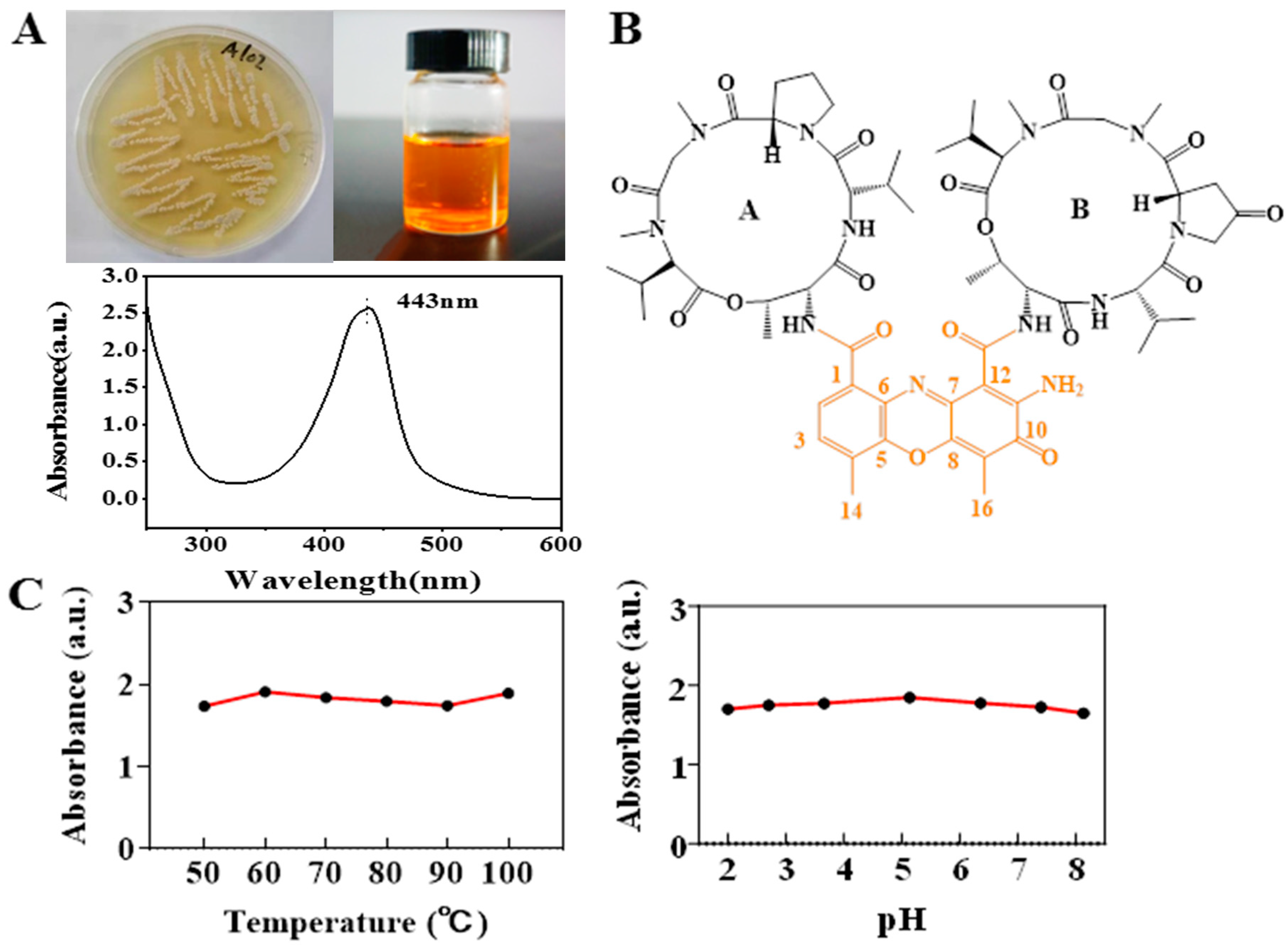
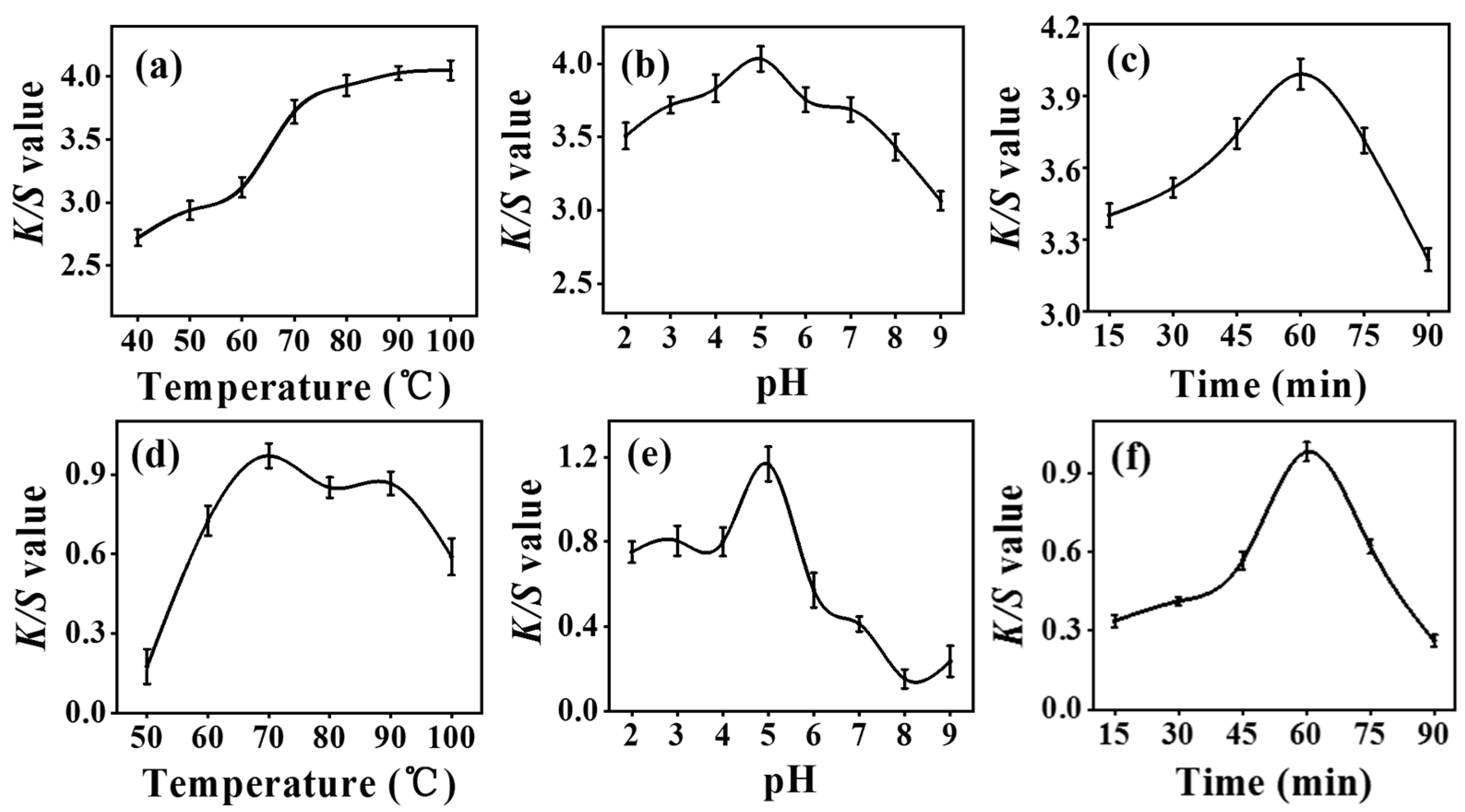
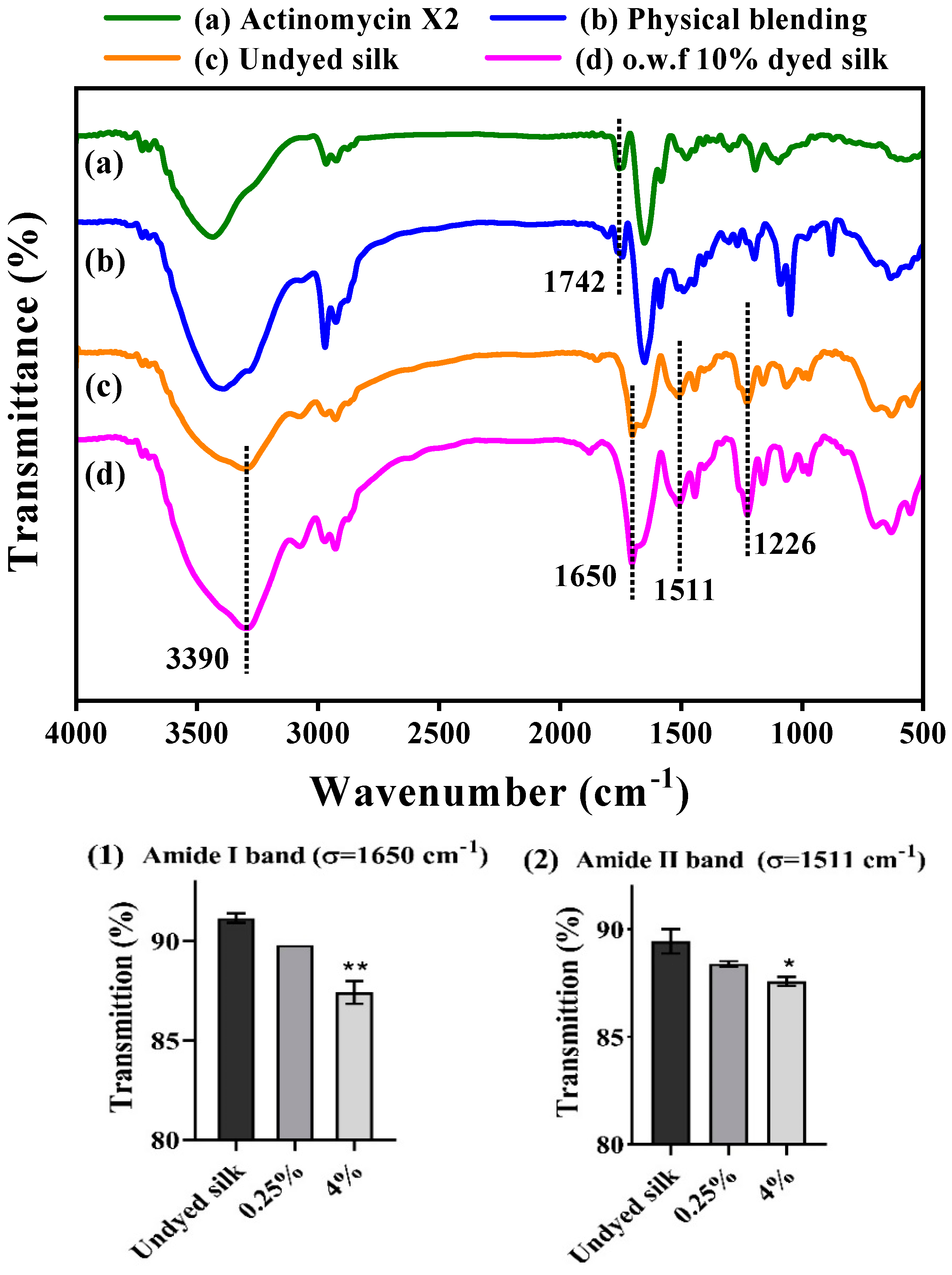
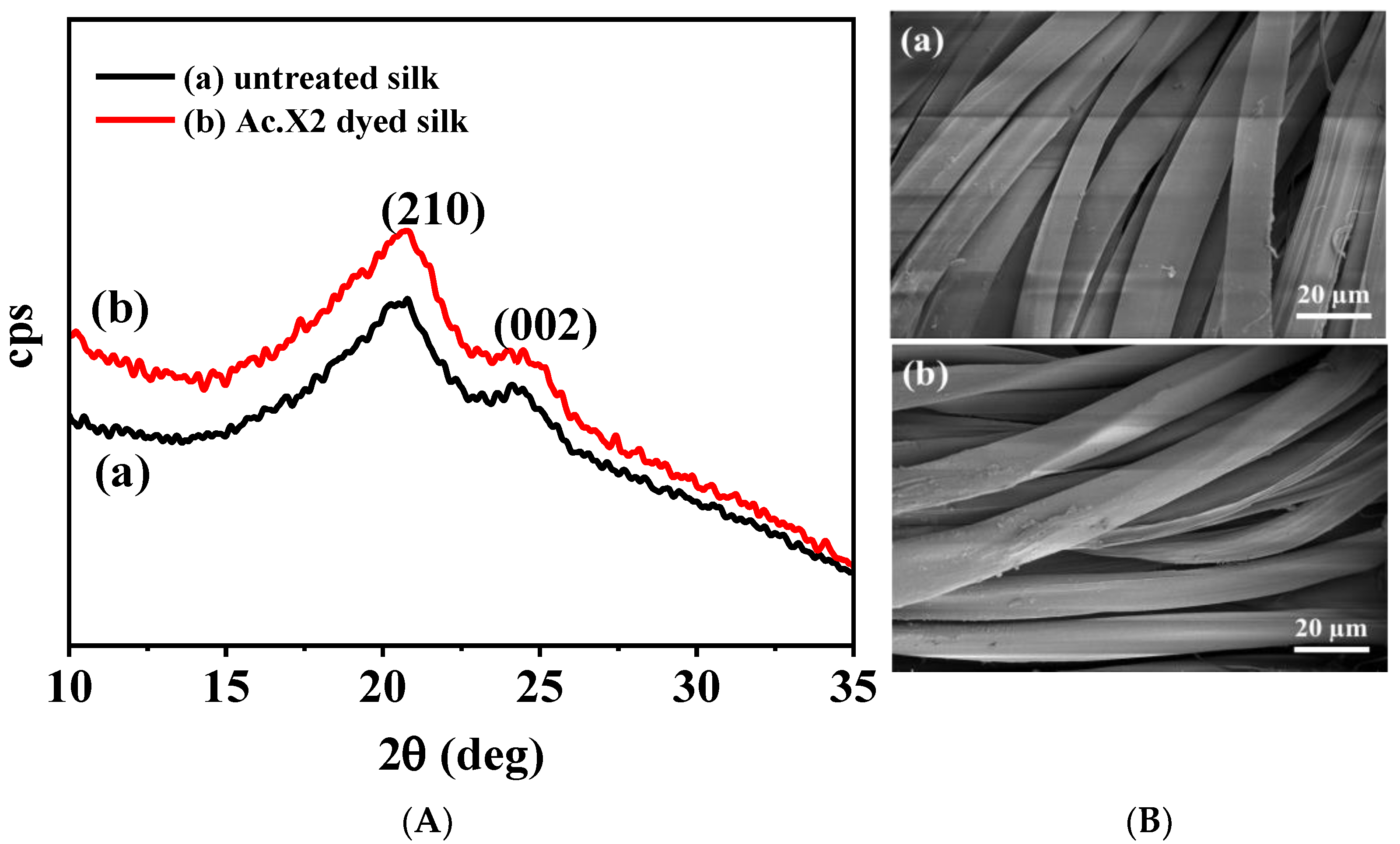
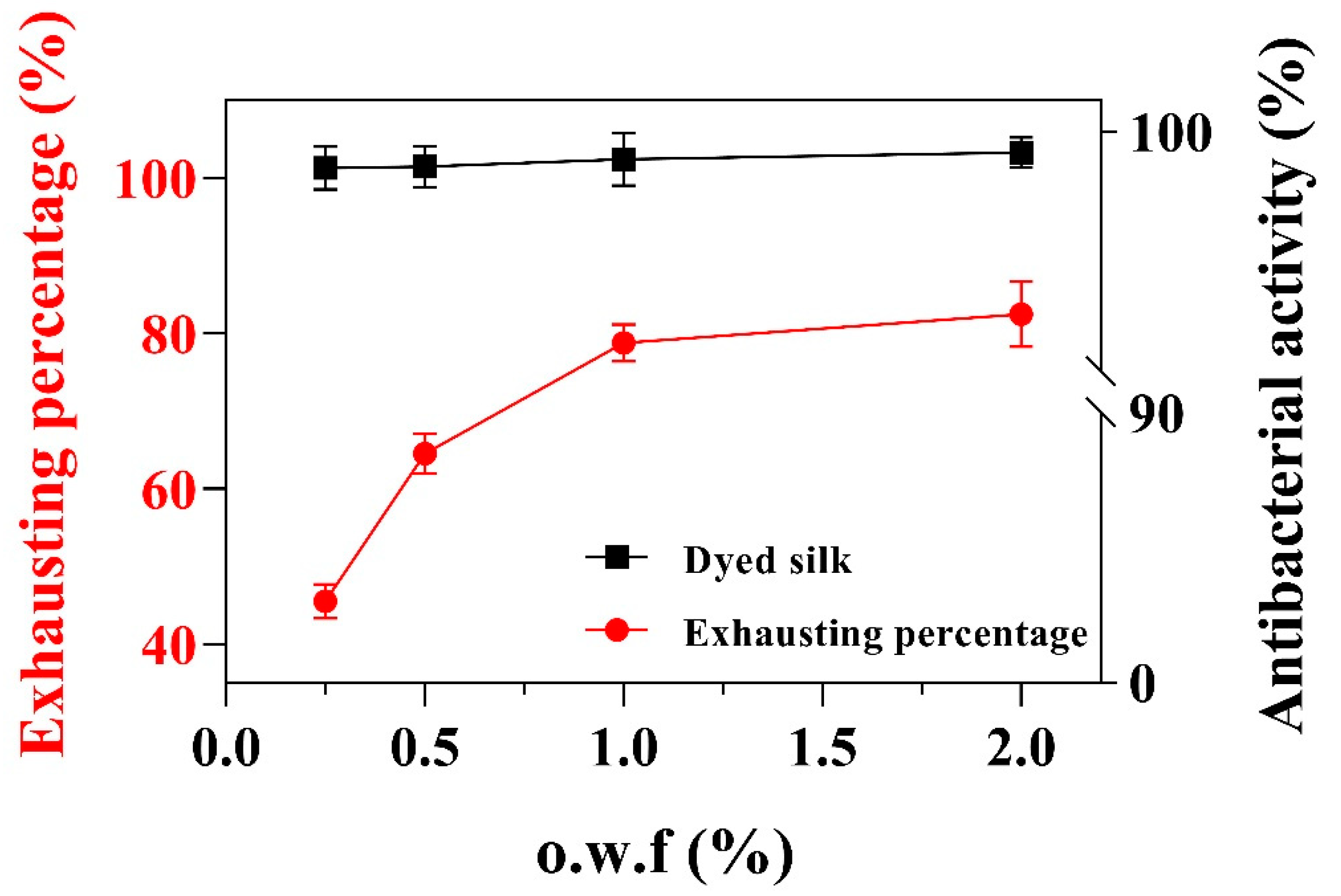
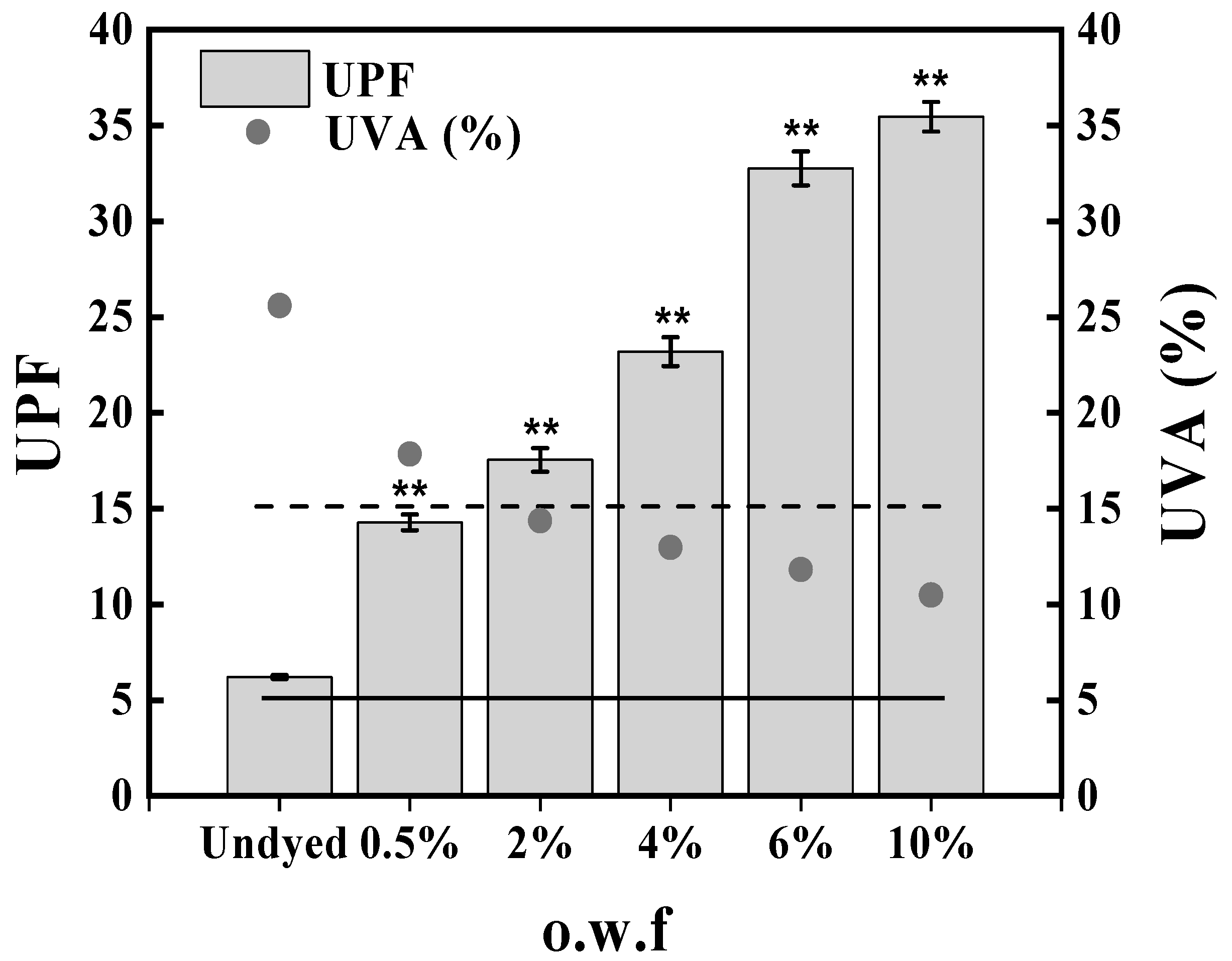

| Fabric Sample | Apparent Color | K/S Value | L* | a* | b* | ΔE* | Percentage Exhaustion (%) |
|---|---|---|---|---|---|---|---|
| Silk |  | 4.0740 | −15.57 | 14.41 | 55.36 | 64.10 | 85.43% |
| Cotton |  | 1.1094 | −10.58 | 10.46 | 38.51 | 50.44 | 20.76% |
| Fabric | After 5 Times Laundering | ΔK/S | After DMF Extraction | ΔK/S | ||
|---|---|---|---|---|---|---|
| A.C. | K/S Value | A.C. | K/S Value | |||
| Silk |  | 3.7444 | −0.3296 |  | 3.7529 | −0.3211 |
| Cotton |  | 0.0464 | −1.063 |  | 0.0689 | −1.0405 |
| o.w.f. | Apparent Color | K/S Value | L * | a * | b * |
|---|---|---|---|---|---|
| 0.1 |  | 0.3657 | −5.17 | 0.66 | 24.85 |
| 0.25 |  | 0.6665 | −6.07 | 0.82 | 28.86 |
| 0.5 |  | 1.1644 | −8.51 | 2.26 | 35.37 |
| 1 |  | 4.0740 | −15.57 | 14.41 | 55.36 |
| 2 |  | 5.3555 | −16.37 | 18.37 | 57.4 |
| 4 |  | 5.8977 | −20.71 | 18.7 | 57.62 |
| Wash Fastness | Rub Fastness | Perspiration Fastness | ||||||||
|---|---|---|---|---|---|---|---|---|---|---|
| Acid | Alkali | |||||||||
| c.c. | s.s. | s.c. | Dry | Wet | c.c. | s.s. | s.c. | c.c. | s.s. | s.c. |
| 4 | 5 | 5 | 4–5 | 4 | 4–5 | 3–4 | 4 | 4–5 | 3–4 | 4 |
Publisher’s Note: MDPI stays neutral with regard to jurisdictional claims in published maps and institutional affiliations. |
© 2021 by the authors. Licensee MDPI, Basel, Switzerland. This article is an open access article distributed under the terms and conditions of the Creative Commons Attribution (CC BY) license (https://creativecommons.org/licenses/by/4.0/).
Share and Cite
Chen, W.; Ye, K.; Zhu, X.; Zhang, H.; Si, R.; Chen, J.; Chen, Z.; Song, K.; Yu, Z.; Han, B. Actinomycin X2, an Antimicrobial Depsipeptide from Marine-Derived Streptomyces cyaneofuscatus Applied as a Good Natural Dye for Silk Fabric. Mar. Drugs 2022, 20, 16. https://doi.org/10.3390/md20010016
Chen W, Ye K, Zhu X, Zhang H, Si R, Chen J, Chen Z, Song K, Yu Z, Han B. Actinomycin X2, an Antimicrobial Depsipeptide from Marine-Derived Streptomyces cyaneofuscatus Applied as a Good Natural Dye for Silk Fabric. Marine Drugs. 2022; 20(1):16. https://doi.org/10.3390/md20010016
Chicago/Turabian StyleChen, Wei, Kaixiong Ye, Xiaoji Zhu, Huihui Zhang, Ranran Si, Jianing Chen, Zijun Chen, Kaili Song, Zhicheng Yu, and Bingnan Han. 2022. "Actinomycin X2, an Antimicrobial Depsipeptide from Marine-Derived Streptomyces cyaneofuscatus Applied as a Good Natural Dye for Silk Fabric" Marine Drugs 20, no. 1: 16. https://doi.org/10.3390/md20010016
APA StyleChen, W., Ye, K., Zhu, X., Zhang, H., Si, R., Chen, J., Chen, Z., Song, K., Yu, Z., & Han, B. (2022). Actinomycin X2, an Antimicrobial Depsipeptide from Marine-Derived Streptomyces cyaneofuscatus Applied as a Good Natural Dye for Silk Fabric. Marine Drugs, 20(1), 16. https://doi.org/10.3390/md20010016







